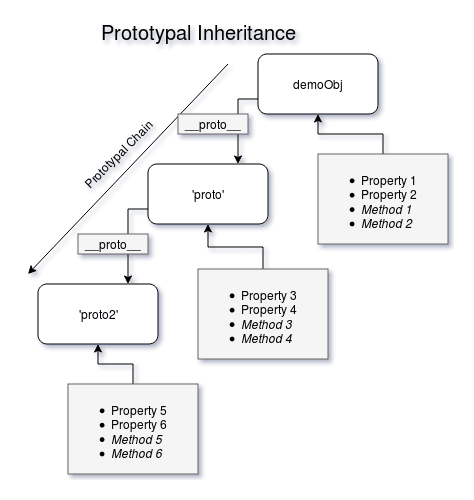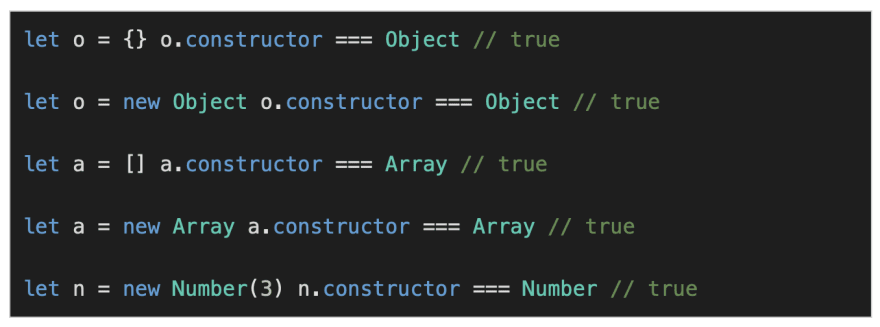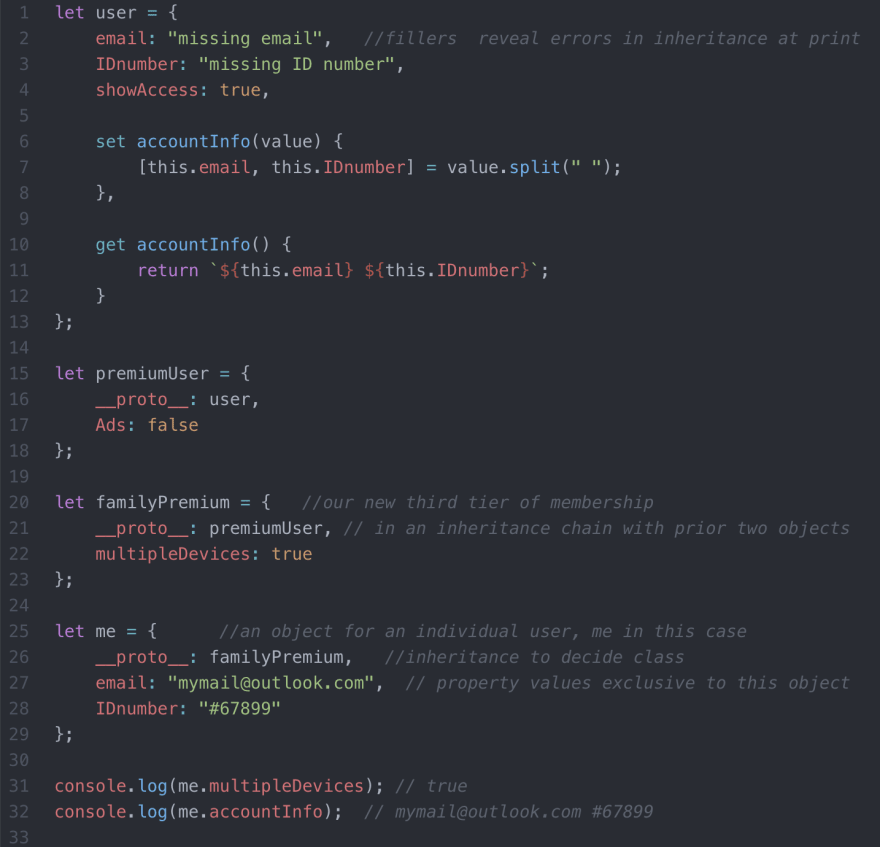Written by Ryan Thelin, a contract technical writer for Educative.inc
JavaScript is a prototype-based, Object Oriented programming language. After the ES6 updates, JavaScript allowed for “prototypal inheritance”, meaning that objects and methods can be shared, extended, and copied. This makes for easy inheritance of structure (data fields), behavior (functions / methods), and state (data values).
JavaScript is the most common of the prototype-capable languages, and its capabilities are relatively unique. When used appropriately, prototypical inheritance in JavaScript is a powerful tool that can save hours of coding.
Today, we want to get you acquainted with prototypal inheritance in JavaScript to get you up to date with the ES6 capabilities.
We will cover the following:
- What is prototypical inheritance?
- Cons of prototypical inheritance
- Important terms
- Setting up prototypical relationships
- Inheriting methods
- Three-Tier Inheritance and Scalability
- Wrapping up and resources
What is prototypical inheritance?
Simply put, prototypical inheritance refers to the ability to access object properties from another object. We use a JavaScript prototype to add new properties and methods to an existing object constructor. We can then essentially tell our JS code to inherit properties from a prototype. Prototypical inheritance allows us to reuse the properties or methods from one JavaScript object to another through a reference pointer function.
All JavaScript objects inherit properties and methods from a prototype:
-
Dateobjects inherit fromDate.prototype. -
Arrayobjects inherit fromArray.prototype. -
Playerobjects inherit fromPlayer.prototype.
The Object.prototype is on top of the prototype inheritance chain. Date objects, Array objects, and Player objects all inherit from Object.prototype.
Image from dsinecos
Revisiting an old example
Let’s walk through an example of prototypical inheritance you’re likely familiar with from grade school: all squares are rectangles, but not all rectangles are squares. If we think of this as a JS program, we could say that the rectangle is a prototype to the square: the square inherits all properties of a rectangle (i.e. four-sides and closed), while also adding a new feature (i.e. all sides are the same length).
We could not, however, construct this same concept using the square as a prototype, because there are properties of a square that do not apply to rectangles (i.e. all sides are the same length).
We can see how prototypal inheritance works on the basis of specifying categories within a group from least specific to most – from rectangle to square. In code, this concept can sometimes be lost in the syntax. If you find this happens, speak the relations between objects and listen to where you draw distinctions. If you hear, "all ___ are __, but...not all __ are___", that is where a new prototypical relationship should be added.
Cons of Prototypal Inheritance
Prototypical inheritance clearly has a lot of benefits for JavaScript programmings, but, like all tools, it does have limitations. Let’s take a look at the key downsides to look out for as you write a prototype-based program:
Inheritance cannot flow in circles as this will create an error. For example, if
userlinkedpremiumFamilyas a prototype in the above program, an error would occur as this would create a loop.Objects cannot inherit from multiple prototypes. As we saw above, they can inherit multiple object's properties through a chain, however another object linked as a prototype explicitly will cause an error. This is the case even if the additional prototype is within the same chain. For example,
familyPremiumcould not have explicit links to bothpremiumUseranduser.Prototypical relationships can only be made to objects. This is because the
__proto__function works as a forwarder, directing the program where to find the value it is looking for. As the program either knows where to look or it doesn’t, the function can be only eithernullor an object. All other types will be discarded.
Important terms
__proto__ property
In Javascript, every object has its own hidden, internal property, [[Prototype]]. We can access that [[Prototype]] using the __proto__ property. This calls the program to mark the template object as a hidden type. JavaScript objects must be linked to this prototype object. Now, an object's properties can be accessed by the inheritor object.
Let’s take a look at the syntax for accessing and setting the [[Prototype]] property of an object.
//using __proto__ to access and set the [[Prototype]] of "anObject"
anObject.__proto__ = someotherObject
Object.create
JavaScript ECMAScript 5 comes with the function Object.create( ). This method can be used to replacenew. We can use it to create an empty object based on a defined prototype and then assign it to a different prototype. Take a look at the syntax:
Object.create(proto, [propertiesObject])
Object.create methods can accept two arguments: propertiesObject and prototypeObject.
Object.prototype.constructor
All objects have a constructor property. If an object is created without the using a constructor function, it will have a constructor property. The constructor property will return a reference to the object’s Object constructor function. It will return 1, true1, and”test”`. Take a look at an example below.
hasOwnProperty
Using hasOwnProperty, we can test if an object contains a certain prototype property; the method will return true or false depending. This will help you clarify if an object has its own property or if it is inheriting instead. Take a look at the syntax below:
js
obj.hasOwnProperty(prop)
The Prototype Chain
Prototypal inheritance uses the concept of prototype chaining. Let’s explore that concept. Every object created contains [[Prototype]], which points either to another object or null. Envision an object C with a [[Prototype]] property that points to object B. Object B’s [[Prototype]] property points to prototype object A. This continues onward, forming a kind of chain called the prototype chain.
This concept is used when searching our code. When we need to find a property in an object, it is first searched for in the object, and if not found, it is searched for on that object’s prototype, and so on. Thus, the entire prototype chain is traversed until the property is found or null is reached.
Want to learn more about Prototypal Chaining? Check out the course Learn Object-Oriented Programming in JavaSrcript
In the following sections, we'll take a look at some implementations using the handling of accounts in a streaming service.
Example Code 1: Setting up Prototypical Relationships
For this first example, we'll write a simple prototypical relationship between two objects, user and premiumUser, using the ._proto_ function. Each of these objects has their own properties which would be shared among all accounts at that tier: all users have access to stream shows, showAccess = true, and all premiumUsers have advertisements disabled, ads = false
The prototypical relationship here ensures that premiumUser inherits the showAccess property set from user without having to set it manually at the premium tier. To check that this has inherited properly, we add a line to have the console print the current value of showAccess for premiumUser. As it returns true, we can see that premiumUser has inherited this property from user.
Example Code 2: Inheriting Methods
Prototypal Inheritance can be used not only to inherit properties from other objects but methods as well. In the example below, we build off our previous code and now add email and IDnumber properties to user, tracking account info for this user, as well as a setter method, accountInfo which when called will parse a passed string, setting email and IDnumber to the new passed values.
The key section of this example is the calling of the three methods at the bottom. Each of these methods are defined under the user object and therefore would usually be inaccessible by premiumUser. However, because user is the prototype of premiumUser, all methods and properties of user are shared with any inheritor objects.
From the final two methods, we also see how the value of the properties shared are not stagnant but can be set to new values regardless of the properties' values in the prototype.
Example Code 3: Three-Tier Inheritance and Scalability
As you might have noticed, the examples above allow for only one account in user and one account in premiumUser. To introduce much needed scalability, we pivot from using these objects as variables and instead use them as an equivalent to classes. Instead of changing properties' values, we create new objects for each account, setting the prototype for that new object based on the tier of the account.
In the example below, the object me will be my account. This object then calls the inherited setter method to set values for the email and IDnumber property exclusive to this account, and set its tier by making the newly added familyPremium object as its prototype. While this is an example using a single account object, this procedure could be scaled to assign the correct properties to any number of objects.
Even with three levels of inheritance, we can see that me has access to data throughout the chain, from the immediately inherited multipleDevices property to the inherited accountInfo method, defined at the top of its chain in user. Regardless of how many levels the inheritance chain has, all information from previous levels are retained and accessible.
Through the use of prototypical inheritance, we're able to create a program in which new accounts can be added and assigned established properties in only a few lines of code rather than having to set manually. It also allows for ease of adaptability of those properties. If we could change properties of all inheritor accounts by only changing the properties in the prototype.
As a result, we get a program which is scalable, adaptable, and efficient in execution, all possible thanks to a prototype-based approach.
Wrapping up and real-world example
Like JavaScript itself, prototypical inheritance is an invaluable tool in the world of website development and server management. Specifically, prototypes and prototypical inheritance are commonly used in many web application frameworks, such as AngularJS, to allow sharing of common behavior and state among similar components.
For example, AngularJS uses hierarchical scopes for inheriting data values for data binding to display on web pages. A Site scope object may define values for the Title and IconImg for a website, then individual Page scope objects may use prototype links to allow sharing of those common data values. It also allows customization for individual web pages by overriding or augmenting the inherited values for certain pages.
Regardless of what syntax is used, whether it’s a streaming service or web page design, prototypical inheritance is a useful tool for all web application development projects.
Resources and further reading
Articles
Top 15 JavaScript Courses: Interested in brushing up on JavaScript and prototypical inheritance skills? Take a look at this article to get started.
Complete Crash Course for ES6 and Beyond: Looking for an overview of ES6 JavaScript? This crash course article walks you through this modern JavaScript since ES6 and beyond.
The Journey to Becoming a Full Stack JS Developer Starts Here: Just starting out on your journey as a JavaScript developer? This article teaches aspiring developers all the need-to-know steps.













Oldest comments (0)